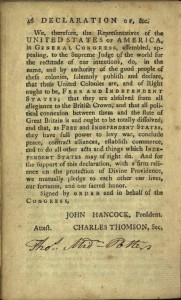“This Mighty Revolution”

By the time that this blog post is published, Ohio’s presidential primary will have passed. Voting is a treasured right in the United States, one for which our ancestors fought, long and hard, and often died. We celebrate the U.S. Constitution as being the document which guarantees that right, but the roots of the Constitution lie in our partnering foundational document, the Declaration of Independence.
Via an easy online search, we can see images of the Declaration of Independence, both in its original format and as it was printed by John Dunlap on July 4, 1776. The original, signed copy of the Declaration is held by the National Archives in Washington, D.C., and only 25 copies of the Dunlap Broadside, as the printed copy by Dunlap is now known, exist today. However, the State Library of Ohio holds a rare, printed version of the Declaration of Independence as it was included in the book The Genuine Principles of the Ancient Saxon, or English Constitution, by “Demophilus,” the pseudonym of George Bryan of Pennsylvania.
Published by Robert Bell, The Genuine Principles is the first printing of the Declaration of Independence in book format. It was published on July 8, 1776; this date is confirmed by the advertisement at the end of the book, which announces the upcoming publication of another book touting American independence. It is likely that The Genuine Principles’ publication was moving forward prior to the signing of the Declaration and that Bell simply included it as an addendum to Bryan’s text, certainly with Bryan’s blessing.

George Bryan was known to be a radical with anti-British sentiments who strongly supported the Declaration. He so believed in personal liberty that he espoused emancipation for slaves, believing that slavery held no place in a nation founded on freedom. The Declaration was a well-suited addition to Bryan’s text, which argues that the “compact of allegiance and protection” between George the Third and the people of Pennsylvania is “totally dissolved” due to the king’s tyranny. “The events which have given birth to this mighty revolution, and will vindicate the provisions that shall be widely made against our ever again relapsing into a state of bondage and misery, cannot be better set forth than in the following Declaration of American Independence,” he says at the conclusion of his own text and as an introduction to the Declaration.
The State Library’s copy of The Genuine Principles of the Ancient Saxon, or English Constitution appears to have belonged to another patriotic American, though we have no records as to who the owner was beyond his name. We do know, however, that Thomas M. Potters signed his name in the book twice: once in the middle of the book and again at the end of the Declaration, under the name John Hancock. We can safely assume by these signatures that Mr. Potters was a supporter of American independence and liberty, as well, and we are proud to have his copy of this remarkable book in our collection.
We hope you enjoy viewing The Genuine Principles of the Ancient Saxons on Ohio Memory, and that you celebrate your inalienable rights, every single day.
Thank you to Shannon Kupfer, Digital/Tangible Media Cataloger at theState Library of Ohio, for this week’s post!



Leave a Reply
You must be logged in to post a comment.